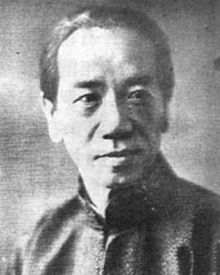Shih Liang-ts'ai (1879-13 November 1934), owner and publisher of the Shun-pao. An entrepreneur with many business interests in Shanghai, he was also a civic leader. He was assassinated in 1934.
Although his native place was Nanking, Shih Liang-ts'ai was born in Ssu-ching-chen, near Shanghai, where his father, Shih Ch'unfan, had moved during the Taiping Rebellion. The young Shih received a traditional education in the Chinese classics to prepare him for a career in the Ch'ing civil service. In reaction to the Boxer Uprising, however, he decided to take up more practical subjects. He spent 1901-3 at the Sericultural School in Hangchow. Immediately after being graduated, he began teaching at several schools in Shanghai. In 1904 he helped to found the Women's Sericultural School at Kao-ch'ang-miao. The school soon moved to Soochow, where some of its graduates worked to develop sericultural enterprises in the fertile T'aihu area. Shih also was instrumental in promoting the General Association of Educational Affairs in Kiangsu, and he became chief editor of the Shih-pao [eastern times] in Shanghai. His agricultural interests led him to found the China Agricultural Association in Nanking and to serve as its general secretary. It was probably in this connection that he was chosen to head a group of experts which appraised the agricultural exhibits at the Nanyang ch'uan-yeh hui [Nanyang exhibition] at Nanking in 1910. Soon after the Wuchang revolt began in October 1911, Shih Liang-ts'ai, who had become prominent in civic affairs, was made a member of the provincial council by Ch'eng Te-ch'uan, the military governor of Kiangsu. Shih became the director of the bureau charged with liquidating customs revenues in Shanghai to meet the pressing financial needs of the revolutionary regime in Kiangsu. In 1912, soon after the republic was established, he was made director of the Sungchiang salt bureau. Also in 1912 Shih Liang-ts'ai became coowner and general manager of the Shun-pao ; in 1915 he became its sole owner. The Shun-pao had been founded in 1872 by a British businessman named Ernest Major. At first, it met with an indifferent reception, but its circulation began to pick up when it published vivid and detailed accounts of the Japanese invasion of Taiwan. In 1884, when a dispute arose between China and France over Indo-China, the Shun-pao provided its readership with on-thespot coverage. In subsequent years, the fame and popularity of the Shun-pao increased after each major national or international crisis. Major left China and entrusted the Shun-pao to a group of Englishmen. In 1909 they sold the paper to Hsi Yü-fu for China S75,000. Three years later, Shih and his friends acquired it for China Si 20,000. By this time, the Shun-pao's daily circulation had reached 7,000 copies. Under Shih's management, the paper's circulation reached 20,000 in 1917, 30,000 in 1918 and 50,000 in 1921. By 1928 it was claiming a paid circulation of 140,000, the largest in China.
Because of the political instability of China in the 1920's and the embryonic state of Chinese journalism, such major Chinese newspapers as the Shun-pao and its chief rival in Shanghai, the Sin-wen-pao [the news] avoided political involvement and devoted much space to news of a non-political nature. Under Shih Liang-ts'ai's guidance, the Shun-pao gradually shifted its reportorial emphases and increased its coverage of political affairs. Shih worked constantly to keep abreast of the times and to improve the Shun-pao. In 1929 he established a planning department to devise ways to streamline operations, and he persuaded Huang Yen-p'ei and Ko Kung-chen (qq.v.) to serve as co-directors. Also in 1929 he and a group of his friends acquired control of the Sin-wen-pao .
Shih soon became interested in subsidiary enterprises and established the Shun-pao Yearbook, the Shun-pao Monthly, a movable library, and supplementary schools. When the paper celebrated its sixtieth anniversary in 1932, Shih commissioned the geologists V. K. Ting (Ting Wen-chiang) and Wong Wen-hao (qq.v.) and the cartographer Tseng Shih-ying to prepare the Shun-pao map of China, which turned out to be the best general and provincial map ever published by a private enterprise in China. After the Mukden Incident in September 1931, the Shun-pao became highly critical of the National Government's Japan policy. Early in 1932 Shih Liang-ts'ai, who had become a prominent civic leader in Shanghai, began to organize the citizens of Shanghai in an effort to maintain peace and order during a period of great panic and much confusion as the Japanese forced their undeclared war on Shanghai. Shih later became the first chairman of the provisional municipal council of Shanghai. His influence in the economic and industrial life of Shanghai was great, for, in addition to his newspaper enterprises, he had helped to found or expand the China and South Seas Bank, the Min-sheng Cotton Mill, the Wu-chou Dispensary Company, and the Chung-hua Book Company. He also served as a member of the Rural Rehabilitation Committee, a vice director of the Wen-ch'i Paper Mill, and a director of the China Merchants' Steam Navigation Company.
Late in 1934 Shih Liang-ts'ai, who suffered from stomach ulcers, went to Hangchow to rest. On his way back to Shanghai on 13 November, he was shot by assassins at Wangchia-pu near Haining, Chekiang. Although the assassins were never identified, it was generally assumed that they had been inspired by Kuomintang authorities who resented the Shun-pao's strong criticism of the National Government's Japan policy. Shih was survived by his wife and a son, Shih Yung-keng.

史量才
原名:家修
史量才(1879—1934.11.13),《申报》老板、发行人。他在上海经营多种企业,又是社会上的闻人。1934年被暗杀。
史量才原籍南京,生在上海附近泗泾慎,他父亲史春帆在太平天国时移居于此。青年时他读古书应科举考试。由于义和团事件,他决心多学一些实际知识。1901—1903年进杭州蚕桑学校,毕业后,在上海各校教书。1904年,他在上海高昌庙协助创办了一所女子蚕桑学校,不久迁到苏州,该校毕业生多人在富饶的太湖区域发展蚕桑业。史比才还积极促成江苏教育总会,同时担任了上海《时报》首任主编。他关心农业建设,在南京创建中国农业协会并担任秘书长之职。可能因此之故,1910年南京举办“南洋劝业会”( 南洋博览会)时,史量才被推荐领导一批专家评议农展品。
1911年武昌起义后不久,史量才已是社会知名人士,由江苏都督程德全推荐为省议会议员,负责清理上海关税,以供江苏革命政府迫切的财政需要。1912年民国政府成立,任命史量才为松江盐务局总监。
1912年,史量才又成为《申报》股东兼总经理,1915年后,由他独家经营。《申报》系1872年英商美查创办。初创时,不为人重视,后因详细报道日本侵占台湾的经过而増加了发行量。1884年中法战争发生后,《申报》向读者作了现场报道。以后每逢国内外发生大事,《申报》的声誉都有増加。美查离中国,《申报》交给英侨经营。1909年,他们以七万五千元把报纸出盘给席裕福。1912年,史量才等数人,以十二万元转手购得。当时《申报》发行量为七千份,在史的经营下,1917年增加为二万份,1918年三万份,1921年五万份。1928年它声称有十四万个订户,成为国内最大的一份报纸。
二十年代国内政局不稳,新闻事业又属初创,当时的《申报》及其主要对手《新闻报》之类,避免卷入政治,大都专登非政治性消息。史量才主持《申报》后,逐渐改变报道重点,增加了政治内容的版面。史虽才注意跟上形势改进《申报》。1929年他建立一个计划部门设计合理化生产过程,又聘请黄炎培、戈公振为副经理。同年他和一些朋友还控制了《新闻报》,不久他兴致制勃勃地办了些附属事业,如《申报年鉴》、《申报月刊》,还创办流动图书馆和附属学校。1932年,《申报》创刊六十周年,他聘请地质学家丁文江、翁文灏,绘图家曾世英编印《申报》中国地图,这是私人出版的一本最好的分省全图。
1931年沈阳事变后,《申报》对国民政府的对日政策严加抨击。早在1932年,史量才已成为上海著名民众领袖。当日本不宣而战,挑起淞沪战争时,史量才开始组织上海民众维持和平与秩序。此后,史量才任上海临时参议会第一任议长。史量才在经济和实业方面对上海的影响很大,因为除新闻事业外,他又参与创设和扩充了中国南洋银行、民生纱厂、五洲药房和中华书局。他又是农村复兴委员会委员,温溪造纸厂副经理,招商局理事。
1934年底,史量才因胃溃疡去杭州休养,11月13日回上海,路过浙江海宁翁家埠时被刺客用枪暗杀。凶手一直没有查明,但一般人都认为系国民党负责当局所指使,因为《申报》对国民政府的对日政策的严厉抨击惹怒了他们。史量才死后,遗有妻子和儿子史咏赓。